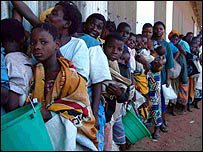 How does it feel to be hungry, really hungry? It is not the kind of hunger that comes with having missed a meal. It is also not the kind of hunger one feels when doing a very purposeful "cleansing fast," or fasting on Fridays, in the old days of an observed liturgical holy week.
How does it feel to be hungry, really hungry? It is not the kind of hunger that comes with having missed a meal. It is also not the kind of hunger one feels when doing a very purposeful "cleansing fast," or fasting on Fridays, in the old days of an observed liturgical holy week.This hunger is that which comes from not getting anything to eat, or very little to eat, on a regular basis for days, weeks, months or years at a time. It comes from not getting a nutritionally balanced diet. This kind of hunger makes it difficult, if not impossible for mothers to nurse their infants. Infants do not grow and thrive if they live. People - adults and children - starve to death, or they die of diseases brought on by malnutrition. There are entire nations starving or desperately endangered today; right now. And there far too many people in these United States that are also hungry. This week, this coming Thanksgiving Day, the weekend following , millions are hungry. For many of the rest of us, we will be trying to figure out what to do with all our leftovers.
A recent Reuters story focused on the just published United Nations report on hunger in the world which states that 6 million children a year die from hunger related causes. (see also the teriffic pop up map in the title link above) Quoting Reuters,
Most of the 6 million child deaths a year are not due to starvation butThe food crisis brought about by climate change is also part of the larger hunger picture. The BBC article begins,
rather to neonatal disorders and diseases like diarrhea, pneumonia, malaria and measles which would be easily curable if the victims were not weakened by lack of nutrition.
Climate change threatens to put far more people at risk of hunger over the next 50 years than previously thought, according to new research. Scientists say expected shifts in rain patterns and temperatures over that time could lead to an extra 50 million people struggling to get enough food.
 (BBC image) In Africa people in Malawi face a maize crisis. Quoting,
(BBC image) In Africa people in Malawi face a maize crisis. Quoting,
The worse harvest in a decade and failed rains are being blamed for what aid agencies warn is a rapidly emerging food crisis. What is making matters worse is HIV/Aids. One in seven people in Malawi is affected and it is fuelling the problem of extreme hunger. Money that households would normally spend on buying seed and fertiliser, is being spent on transporting the sick to hospital and buying basic medicine instead.
In Zimbabwe even their own soldiers are hungry enough that there are shortages of food in the barracks and forced leaves. High food prices are a factor in Niger's hunger problems, because of the high demand for food in the surrounding countries. The crisis of African hunger was debated in this BBC feature; some of the discussion comments were excellent. Millions are at risk in Africa, but so are millions in southern Asia
Earthquake survivors face winter hunger in the Kashmir area. It is a major crisis for the millions left homeless by the quakes in Pakistan, Kashmir and India. The article states, "As of 16 October, food had reached 440,000 people but an estimated 560,000 remained in "desperate need of assistance".
In our own hemisphere hunger is a major problem in several contries. The BBC reports that Guatemalans face hunger as a result of the recent natural disaster, Hurricane Stan. Rats ate the crops of many people in Nicaragua, one of the poorest nations in the Central America. The BBC article headlines, "The UN is to send 230 tons of emergency food aid to thousands of Miskito Indians facing hunger in Nicaragua."
Here at home, the Food Research and Action Center is an excellent site for exploring hunger in the United States. America's Second Harvest, the nation's food bank network, has excellent material on hunger in the U. S. The Children's Defense Fund explores the question of U.S. children's hunger in this 6-page PDF document. Here is what the USDA site has to say about "food security" in the U.S.:
Eighty-eight percent of American households were food secure throughout the entire year 2004, meaning that they had access, at all times, to enough food for an active, healthy life for all household members. The remaining households were food insecure at least some time during that year. The prevalence of food insecurity was 11.9 percent in 2004, up from 11.2 percent in 2003. The prevalence of food insecurity with hunger was 3.9 percent in 2004, up from 3.5 percent in 2003.
Since our population was 290,342,554 in July of 2003, the "3.9% of food insecurity with hunger" translates into 11, 323,360 hungry people in the United States. Is there anything that can be done about the recent increase in hunger? The above paragraph on hunger in America includes several references in the linked articles to organizations that endeavor to feed people who go to bed hungry. In your own city, there is probably a food bank, a soup kitchen or a homeless shelter that could use some help, either volunteering or donating. And many churches, synagogues and mosques as well as other faith based organizations focus of food pantries or feeding programs.
World wide, diminishing poverty and the predominance of violence and war will help. Improvements in agriculture are key to the long term solution. For example, unravelling the DNA code of the rice genome may be an answer for many countries where rice is the predominant staple.
Reference: Wikipedia's excellent section on hunger discusses many aspects of the problem and includes links to many organizations that work on hunger.
Tag hunger
No comments:
Post a Comment